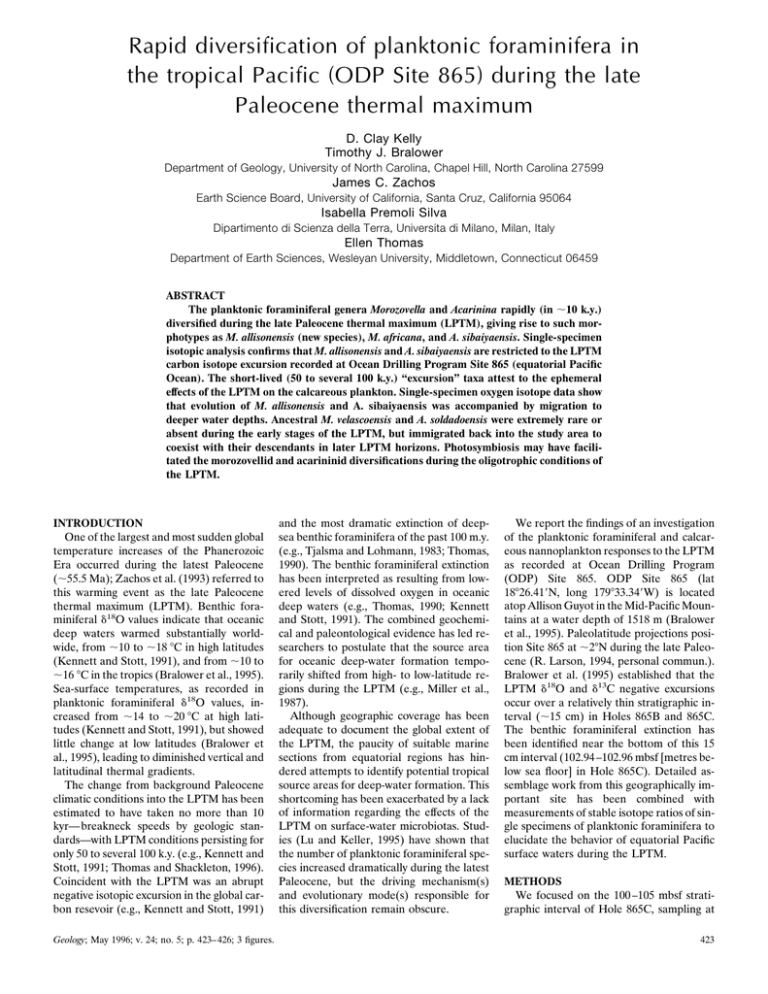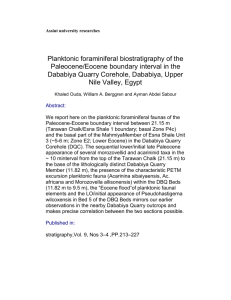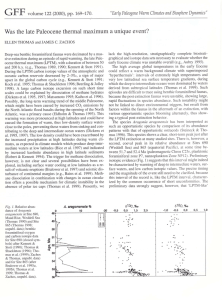Rapid diversification of planktonic foraminifera in
advertisement

Rapid diversification of planktonic foraminifera in the tropical Pacific (ODP Site 865) during the late Paleocene thermal maximum D. Clay Kelly Timothy J. Bralower Department of Geology, University of North Carolina, Chapel Hill, North Carolina 27599 James C. Zachos Earth Science Board, University of California, Santa Cruz, California 95064 Isabella Premoli Silva Dipartimento di Scienza della Terra, Universita di Milano, Milan, Italy Ellen Thomas Department of Earth Sciences, Wesleyan University, Middletown, Connecticut 06459 ABSTRACT The planktonic foraminiferal genera Morozovella and Acarinina rapidly (in ;10 k.y.) diversified during the late Paleocene thermal maximum (LPTM), giving rise to such morphotypes as M. allisonensis (new species), M. africana, and A. sibaiyaensis. Single-specimen isotopic analysis confirms that M. allisonensis and A. sibaiyaensis are restricted to the LPTM carbon isotope excursion recorded at Ocean Drilling Program Site 865 (equatorial Pacific Ocean). The short-lived (50 to several 100 k.y.) ‘‘excursion’’ taxa attest to the ephemeral effects of the LPTM on the calcareous plankton. Single-specimen oxygen isotope data show that evolution of M. allisonensis and A. sibaiyaensis was accompanied by migration to deeper water depths. Ancestral M. velascoensis and A. soldadoensis were extremely rare or absent during the early stages of the LPTM, but immigrated back into the study area to coexist with their descendants in later LPTM horizons. Photosymbiosis may have facilitated the morozovellid and acarininid diversifications during the oligotrophic conditions of the LPTM. INTRODUCTION One of the largest and most sudden global temperature increases of the Phanerozoic Era occurred during the latest Paleocene (;55.5 Ma); Zachos et al. (1993) referred to this warming event as the late Paleocene thermal maximum (LPTM). Benthic foraminiferal d18O values indicate that oceanic deep waters warmed substantially worldwide, from ;10 to ;18 8C in high latitudes (Kennett and Stott, 1991), and from ;10 to ;16 8C in the tropics (Bralower et al., 1995). Sea-surface temperatures, as recorded in planktonic foraminiferal d18O values, increased from ;14 to ;20 8C at high latitudes (Kennett and Stott, 1991), but showed little change at low latitudes (Bralower et al., 1995), leading to diminished vertical and latitudinal thermal gradients. The change from background Paleocene climatic conditions into the LPTM has been estimated to have taken no more than 10 kyr— breakneck speeds by geologic standards—with LPTM conditions persisting for only 50 to several 100 k.y. (e.g., Kennett and Stott, 1991; Thomas and Shackleton, 1996). Coincident with the LPTM was an abrupt negative isotopic excursion in the global carbon resevoir (e.g., Kennett and Stott, 1991) Geology; May 1996; v. 24; no. 5; p. 423– 426; 3 figures. and the most dramatic extinction of deepsea benthic foraminifera of the past 100 m.y. (e.g., Tjalsma and Lohmann, 1983; Thomas, 1990). The benthic foraminiferal extinction has been interpreted as resulting from lowered levels of dissolved oxygen in oceanic deep waters (e.g., Thomas, 1990; Kennett and Stott, 1991). The combined geochemical and paleontological evidence has led researchers to postulate that the source area for oceanic deep-water formation temporarily shifted from high- to low-latitude regions during the LPTM (e.g., Miller et al., 1987). Although geographic coverage has been adequate to document the global extent of the LPTM, the paucity of suitable marine sections from equatorial regions has hindered attempts to identify potential tropical source areas for deep-water formation. This shortcoming has been exacerbated by a lack of information regarding the effects of the LPTM on surface-water microbiotas. Studies (Lu and Keller, 1995) have shown that the number of planktonic foraminiferal species increased dramatically during the latest Paleocene, but the driving mechanism(s) and evolutionary mode(s) responsible for this diversification remain obscure. We report the findings of an investigation of the planktonic foraminiferal and calcareous nannoplankton responses to the LPTM as recorded at Ocean Drilling Program (ODP) Site 865. ODP Site 865 (lat 18826.419N, long 179833.349W) is located atop Allison Guyot in the Mid-Pacific Mountains at a water depth of 1518 m (Bralower et al., 1995). Paleolatitude projections position Site 865 at ;28N during the late Paleocene (R. Larson, 1994, personal commun.). Bralower et al. (1995) established that the LPTM d18O and d13C negative excursions occur over a relatively thin stratigraphic interval (;15 cm) in Holes 865B and 865C. The benthic foraminiferal extinction has been identified near the bottom of this 15 cm interval (102.94 –102.96 mbsf [metres below sea floor] in Hole 865C). Detailed assemblage work from this geographically important site has been combined with measurements of stable isotope ratios of single specimens of planktonic foraminifera to elucidate the behavior of equatorial Pacific surface waters during the LPTM. METHODS We focused on the 100 –105 mbsf stratigraphic interval of Hole 865C, sampling at 423 Figure 1. Planktonic foraminiferal and nannofossil assemblage changes in uppermost Paleocene strata from ODP Hole 865C. Biostratigraphy at left is after Bralower et al. (1995); arrow denotes benthic foraminiferal extinction. Relative abundances of planktonic foraminiferal groups (middle) and nannofossil genera Ericsonia and Toweius (right). 2– 6 cm intervals within the isotopic excursion and 50 –70 cm intervals over the remainder of the study interval (Fig. 1). Assemblage diversity and relative abundance data were determined by picking a minimum of 300 planktonic foraminifera from the .125 mm size fraction of each sample. Morphological and paleoecological criteria were used to divide the planktonic foraminifera into 11 broadly defined groups. For comparative purposes, taxa (e.g., the chiloguembelinids, pseudohastigerinids, globanomalinids, and ‘‘Globorotalia’’ imitata) with erratic stratigraphic ranges and very low abundances have been assigned to a ‘‘miscellaneous taxa’’ group. Assemblage studies were also conducted on calcareous nannofossils in 26 samples across the LPTM. Three hundred specimens were counted in each sample. The species relative abundance data were then grouped into genera to more clearly delineate trends. Isotopic analyses were conducted on single specimens of several species belonging to the planktonic foraminiferal genera Morozovella, Acarinina, and Subbotina. All specimens were picked from three stratigraphic horizons (102.86, 102.90, 102.94 mbsf) within the LPTM d13C excursion. To ensure internal consistency and preclude any size-dependent isotopic trends (e.g., Shackleton et al., 1985), all stable isotope measurements were performed on specimens picked from a restricted size range (300 –355 mm). Individual foraminifera were sonicated in distilled water to remove ad424 hering particles and then were roasted in vacuo at 380 8C. All specimens were analyzed by using an Autocarb device coupled to a Fisons Prism located at the University of California, Santa Cruz. In this system each sample is reacted in a common phosphoric acid bath at 90 8C. Average precision for samples smaller than 40 mg, as determined from replicate analyses of NBS-19 and CM, a laboratory standard, was better than 60.01 for both d18O and d13C values. All isotopic values are reported relative to the Peedee belemnite (PDB) standard. LATEST PALEOCENE EXCURSION MICROBIOTAS High-resolution sampling of latest Paleocene sediments from Site 865 reveals that the calcareous plankton underwent marked changes during the LPTM (Fig. 1). The genera Morozovella and Acarinina dominate planktonic foraminiferal assemblages and display striking increases in morphological variation. This transient diversification gave rise to a suite of distinctive, short-lived morphotypes that are restricted to the 15 cm interval in which the carbon isotope excursion is recorded. These ‘‘excursion’’ taxa reach their peak abundance (;16.5%) at 102.90 mbsf. Synchronous with the sudden appearance of the excursion taxa is a nearly tenfold increase in the relative abundance of the Acarinina soldadoensis group and decreases in the Morozovella subbotinae, Igorina albeari, and weakly keeled morozovellid groups; the relative abundance of the Sub- Figure 2. Scanning electron micrographs of ‘‘excursion’’ taxon Acarinina sibaiyaensis (1a, ventral view; 1b, edge view) and proposed evolutionary sequence (2a–7b) from Morozovella velascoensis (2a, ventral view; 2b, edge view) to Morozovella allisonensis (7a, ventral view; 7b, edge view). All specimens from 102.90 mbsf. Scale represents 100 mm. botina group also exhibits a decrease, albeit less marked. Two of the excursion taxa (Acarinina sibaiyaensis [Fig. 2, 1a and 1b] and Morozovella africana) have been described by El Naggar (1966) from the upper Paleocene of the Nile Valley of Egypt. Morozovella allisonensis (Fig. 2, 7a and 7b), a new species, is the most abundant of the excursion taxa and has no previously published record. Cursory examination of deep-sea sediments from other latest Paleocene sections (Deep Sea Drilling Project [DSDP] Site 577, DSDP Site 527, and ODP Site 690) suggests that this unique assemblage is chiefly restricted to tropical regions. Changes in the nannoplankton further attest to the impact of the LPTM on the surface-water ecosystem (Fig. 1). Species of Ericsonia (E. cava, E. ovalis, and E. subpertusa) and Toweius (mostly etched shields of T. eminens and T. pertusus) dominate assemblages, accounting for ;80% of specimens counted. Within the 15 cm LPTM interval, a marked (20%) increase is observed in the relative abundance of Ericsonia, together with a concomitant (20%) decrease in the number of Toweius. GEOLOGY, May 1996 Figure 3. Right: Stable carbon isotope stratigraphies for uppermost Paleocene section recovered from ODP Hole 865C (from Bralower et al., 1995). The d13C curves are based on multispecimen (8 –10) samples of Morozovella velascoensis (circles), Acarinina soldadoensis (triangles), and Subbotina spp. (pluses). Left: Bivariate plots of singlespecimen stable isotope data from three sample horizons (102.94, 102.90, and 102.86 mbsf) within carbon isotope excursion. Open circles—M. velascoensis; solid circles—M. allisonensis; open triangles—A. soldadoensis; solid triangles—A. sibaiyaensis; and pluses—Subbotina spp. Shaded areas circumscribe nonexcursion specimens. APPLICATIONS OF SINGLE-SPECIMEN STABLE ISOTOPE DATA Short-lived paleoceanographic events such as the LPTM are ideally suited for single-specimen isotopic analysis (e.g., Stott, 1992); it is possible to isotopically distinguish in situ specimens from those that have been mixed into the LPTM horizons. In all three of the LPTM sample horizons examined, the single-specimen isotopic data separate into two distinct groups offset by ;2‰ in their carbon isotope signatures (Fig. 3). This bimodality signifies the presence of both reworked specimens with high d13C values (.3‰) and in situ specimens with anomalously low d13C values (,2‰). For example, of the 29 randomly picked specimens of M. velascoensis from the 102.90 m horizon (Fig. 3), only 7 have excursion d13C values. In other words, nearly 75% of M. velascoensis are contaminants mixed into the 102.90 m sample; this rough estimate suggests that the M. velascoensis group composes considerably less of the 102.90 m assemblage than the reported 15%. Likewise, the Acarinina soldadoensis group appears to be about half as abundant in the 102.90 m sample as conventional assemblage counts indicate. Thus, all three nonexcursion groups are composed solely of specimens of ancestral species that pre- and postdate the LPTM carbon isotope excursion. All specimens of M. allisonensis (44 of 44) and A. sibaiyaensis (28 of 28) recorded anomalously low d13C values, confirming that these morphotypes are restricted to the LPTM carbon isotope excursion interval. The relatively low d13C values measured from members of the genus Subbotina GEOLOGY, May 1996 merely reflect their deeper depth-habitat and/or lack of photosymbionts (Fig. 3). Since the subbotinid d13C values do not significantly depart from pre- and postexcursion d13C values (;2.0‰) reported by Bralower et al. (1995), all 20 specimens from the 102.90 m sample are considered reworked. These findings show that conventional counting methods have grossly underestimated the relative abundances of M. allisonensis and associated excursion taxa. Evolutionary and Paleoecological Implications The responsiveness of the surface-water microbiota to oceanographic change is exemplified by the rapid (;10 k.y.) evolution of Morozovella allisonensis from M. velascoensis (Fig. 2, 2a to 7b). The rapidity at which the short-lived (;50 to several 100 k.y.) M. allisonensis and associated excursion taxa evolved ranks among the fastest known in the pelagic protista. The suddenness of this evolutionary event raises the possibility that these excursion taxa evolved elsewhere and immigrated into the study area. However, the presence of transitional forms linking M. allisonensis to M. velascoensis and A. sibaiyaensis to A. soldadoensis argues against such a scenario. The stratigraphic succession of singlespecimen isotopic data (Fig. 3) taken from within the carbon isotope excursion discloses interesting paleobiogeographic and paleoecologic trends. In the lowermost excursion sample analyzed (102.94 mbsf, which corresponds to the benthic foraminiferal extinction horizon), none of the randomly picked specimens of M. velascoensis or A. soldadoensis register excursion d13C values. This finding suggests that these ancestral species emigrated out of the study area and/or were too rare to detect during the early stages of the LPTM. Thus, the excursion group of the 102.94 m horizon is composed exclusively of M. allisonensis and A. sibaiyaensis specimens. The local paucity of ancestral forms was temporary, for in subsequent stratigraphic horizons (102.90and 102.86 mbsf), specimens of M. velascoensis and A. soldadoensis with excursion d13C values become more abundant. We infer from this stratigraphic sequence that M. velascoensis and A. soldadoensis immigrated back into the study area to coexist with their descendants. Similar evolutionary rates and patterns of paleobiogeographic variation have been observed in the Neogene planktonic foraminifera (Wei and Kennett, 1988). Although M. velascoensis and M. allisonensis coexisted in sample 102.90 m, the two occupied distinctly different paleoecological niches. The generally higher d18O values of M. allisonensis (Fig. 3) suggest that it inhabited a deeper depth-habitat than M. velascoensis. The evolutionary trends in both morphology (axial compression) and ecology (descent to a deeper depth-habitat) resemble those reported by Norris et al. (1993) for the Neogene planktonic foraminiferal Globorotalia (Fohsella) lineage. During the later stages of the LPTM (102.86 m in Fig. 3), some of the excursion specimens of M. velascoensis and most specimens of A. sibaiyaensis begin to record relatively higher d18O values. This indicates that parts of these populations migrated downward to occupy the same depth-habitat as M. allisonensis. Thus, planktonic foraminiferal groups (morozovellids and acarininids), typically regarded as inhabitants of the shallow mixed layer (Boersma et al., 1987), descended through the water column to live at depths previously inhabited by the genus Subbotina. A notable exception to this paleoecological change is A. soldadoensis, which appears to have retained its near-surface habitat, as inferred from its relatively low d18O values. PALEOCEANOGRAPHIC INTERPRETATIONS The unique microfossil assemblages associated with the LPTM interval at Site 865 beg the question, What paleoceanographic conditions triggered the transient biotic responses seen in the calcareous plankton? The diverse but impoverished benthic foraminiferal faunas at Site 865 suggest that the overlying surface waters were highly oligotrophic during the late Paleocene. Although depauperate, these assemblages do 425 exhibit a modest increase in accumulation rates and become dominated by Tappanina selmensis and several buliminid taxa within the 15 cm LPTM interval. These changes could signify an increase in surface-water productivity, leading to an increased flux of particulate organic matter to the sea floor. However, we attribute the benthic foraminiferal assemblage changes to increased preservation of particulate organic matter on the sea floor due to decreased oxygenation in temporarily warmer waters. In nannoplankton assemblages, PeleoAlampay and Wei (1993) noticed an increase in the abundance of the warm-water genus Discoaster within the LPTM at Sites 577 and 690. The observed increase in Ericsonia, a group that is more common in low-latitude water masses, and decrease in Toweius, which is more abundant in midto high-latitude oceans, is also consistent with warming (Fig. 1). However, because sea-surface temperatures at Site 865 only increased by ;1 8C (Bralower et al., 1995), it is conceivable that another paleoecological change (e.g., oligotrophy) caused the nannoplankton assemblage response. Indeed, Ericsonia and Discoaster are considered to have oligotrophic affinities and Toweius eutrophic affinities (M.-P. Aubry, 1995, personal commun.). The preponderance of morozovellids and acarininids, plus the dearth of subbotinids, within the LPTM interval at Site 865 is consistent with oligotrophic conditions. D’Hondt et al. (1994) noted that the stable isotope signatures of the morozovellids and acarininids are comparable to those of modern, photosymbiont-bearing planktonic foraminifera. Foraminiferal groups that host photosymbiotic algae thrive under nutrient-depleted conditions; photosymbiosis has been a recurrent adaptation throughout the evolutionary history of the foraminifera (Hallock et al., 1991). Thus, the added nutrition provided by photosymbiosis conferred a considerable adaptive advantage upon the morozovellids and acarininids, thereby facilitating their evolutionary success during the LPTM. The shift to deeper depth-habits by the morozovellid and acarininid excursion taxa may have been induced by changes in the thermal structure of the water column. The sudden warming of oceanic deep waters and no change in sea-surface temperatures would have greatly diminished the thermocline at Site 865. Biolimiting nutrients would have been diffusely distributed throughout a weakly stratified water column, leading to deepening of a poorly defined nutricline. The resultant decrease in surfacewater productivity would have permitted 426 the euphotic zone to deepen at Site 865, allowing the photosymbiont-bearing morozovellids and acarininids to explore deeper depth-habitats. CONCLUSIONS The near-surface dwelling planktonic foraminifera rapidly (;10 k.y.) diversified during the late Paleocene thermal maximum (LPTM) at ODP Site 865. The short-lived (50 to several 100 k.y.) taxa Morozovella allisonensis (new species), M. africana, and Acarinina sibaiyaensis originated during this transient episode of paleoceanographic change. Single-specimen isotopic data show that all specimens of M. allisonensis and A. sibaiyaensis are restricted to the LPTM carbon isotope excursion. Single-specimen isotopic analysis also reveals that the morozovellids and acarininids underwent parallel patterns of paleoecological and paleobiogeographical variation during the evolution of the LPTM taxa. We postulate that this sudden diversification was related to extreme oligotrophy caused by changes in the thermal structure of the water column. The ephemeral effects of the LPTM on the calcareous plankton are in striking contrast to the coeval, global mass extinction suffered by the deep-sea benthic foraminifera. ACKNOWLEDGMENTS Supported by National Science Foundation grants to Bralower (EAR-94-05784) and Zachos and Thomas (EAR-94-06099). Financial assistance also provided by JOI/USSAC and Martin Research Fellowships to Kelly. We thank R. Norris and M. Leckie for critically reviewing the manuscript, R. Olsson and W. Berggren for helpful discussions, and K. Billups for laboratory assistance. REFERENCES CITED Berggren, W. A., and Miller, K. G., 1988, Paleogene planktonic foraminiferal biostratigraphy and magnetobiochronology: Micropaleontology, v. 34, p. 362–380. Boersma, A., Premoli Silva, I., and Shackleton, N. J., 1987, Atlantic Eocene planktonic foraminiferal paleohydrographic indicators and stable isotope paleoceanography: Paleoceanography, v. 2, p. 287–333. Bralower, T. J., Zachos, J. C., Thomas, E., Parrow, M., Paull, C. K., Kelly, D. C., Premoli Silva, I., Sliter, W. V., and Lohmann, K. C., 1995, Late Paleocene to Eocene paleoceanography of the equatorial Pacific Ocean: Stable isotopes recorded at ODP Site 865, Allison Guyot: Paleoceanography, v. 10, p. 841– 865. D’Hondt, S., Zachos, J. C., and Schultz, G., 1994, Stable isotopic signals and photosymbiosis in late Paleocene planktonic foraminifera: Paleobiology, v. 20, p. 391– 406. El Naggar, Z. R., 1966, Stratigraphy and planktonic foraminifera in the Upper Cretaceous– Lower Tertiary succession in the Esna-Idfu region, Nile Valley, Egypt, U.A.R.: British Museum of Natural History Bulletin, v. 2, 291 p. Hallock, P., Premoli Silva, I., and Boersma, A., Printed in U.S.A. 1991, Similarities between planktonic and larger foraminiferal evolutionary trends through Paleogene paleoceanographic changes: Palaeogeogeography, Palaeoclimatology, Palaeoecology, v. 83, p. 49– 64. Kennett, J. P., and Stott, L. D., 1991, Abrupt deep-sea warming, paleoceanographic changes and benthic extinctions at the end of the Palaeocene: Nature, v. 353, p. 225–229. Lu, G., and Keller, G., 1995, Ecological stasis and saltation: Species richness change in planktic foraminifera during the late Paleocene to early Eocene, DSDP Site 577: Palaeogeography, Palaeoclimatology, Palaeoecology, v. 117, p. 211–227. Miller, K. G., Janacek, T. R., Katz, M. E., and Keil, D. J., 1987, Abyssal circulation and benthic foraminiferal changes near the Paleocene/Eocene boundary: Paleoceanography, v. 2, p. 741–761. Norris, R. D., Corfield, R. M., and Cartlidge, J. E., 1993, Evolution of depth ecology in the planktic foraminifera lineage Globorotalia (Fohsella): Geology, v. 21, p. 975–978. Okada, H., and Bukry, D., 1980, Supplementary modification and introduction of code numbers to the low latitude coccolith biostratigraphic zonation (Bukry, 1973; 1975): Marine Micropaleontology, v. 5, p. 321–325. Peleo-Alampay, A., and Wei, W., 1993, Nannofossil response to the abrupt warming event near the Paleocene/Eocene boundary: Its paleoceanographic and paleoclimatic implications: International Nannoplankton Association Newsletter, no. 15, p. 83. Shackleton, N. J., Corfield, R. M., and Hall, M. A., 1985, Stable isotope data and the ontogeny of Paleocene planktonic foraminifera: Journal of Foraminiferal Research, v. 15, p. 321–336. Stott, L. D., 1992, Higher temperatures and lower pCO2: A climate enigma at the end of the Paleocene epoch: Paleoceanography, v. 7, p. 395– 404. Thomas, E., 1990, Late Cretaceous– early Eocene mass extinction in the deep-sea, in Sharpton, V., and Ward, P., eds., Global catastrophes: Geological Society of America Special Paper 247, p. 481– 496. Thomas, E., and Shackleton, N. J., 1996, The Palaeocene-Eocene benthic foraminiferal extinction and stable isotope anomalies, in Knox, R. W. O’B., Corfield, R., and Dunay, R. E., eds., Correlation of the early Paleogene in northwest Europe: Geological Society of London Special Publication, v. 101, p. 401– 441. Tjalsma, R. C., and Lohmann, G. P., 1983, Paleocene-Eocene bathyal and abyssal benthic foraminifera from the Atlantic Ocean: American Museum of Natural History, Micropaleontology Special Publication, v. 4, 90 p. Wei, K. Y., and Kennett, J. P., 1988, Phyletic gradualism and punctuated equilibrium in the late Neogene planktonic foraminiferal clade Globoconella: Paleobiology, v. 14, p. 345–363. Zachos, J. C., Lohmann, K. C., Walker, J. C. G., and Wise, S. W., 1993, Abrupt climate change and transient climates during the Paleogene: A marine perspective: Journal of Geology, v. 101, p. 191–213. Manuscript received August 25, 1995 Revised manuscript received January 22, 1996 Manuscript accepted January 30, 1996 GEOLOGY, May 1996






